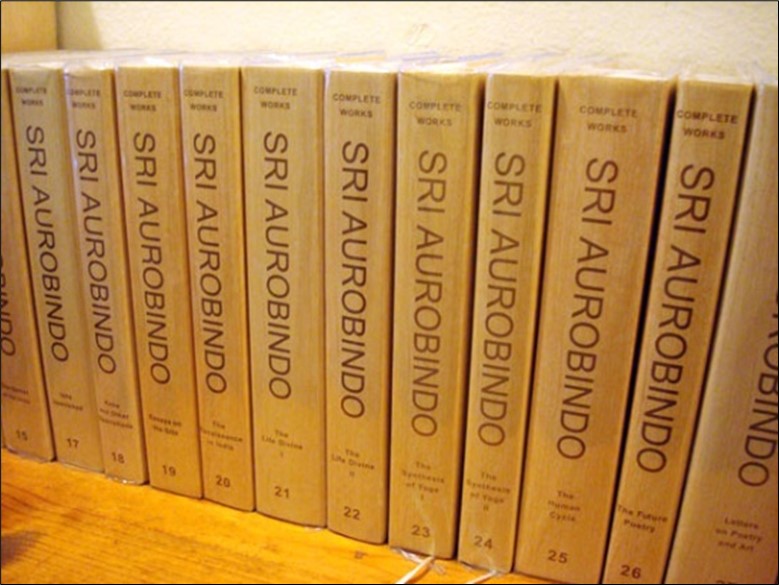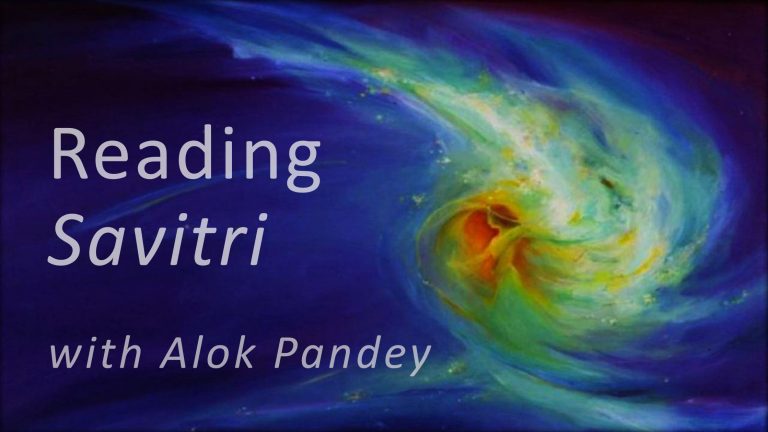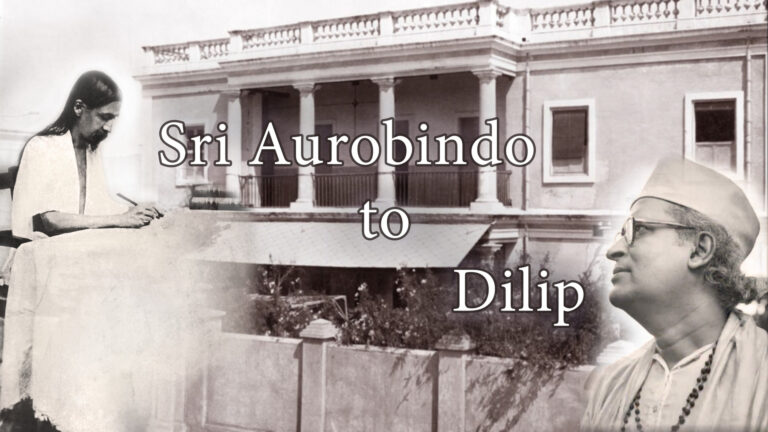 When one looks at the immensity of Sri Aurobindo’s Works it can be both appalling and enthralling. It is appalling when we look at the sheer volume of it all, written in the best of English with a style and substance that we are not often used to. The modern man flooded with information available at a push-button, his life busy with the trivia and the insignificant, his motives often all too ordinary and utilitarian is not accustomed to serious uplifting thoughts that can transport him to realms of Light and Delight as if carried by magical waves. He would rather content himself with the mixed shades of earthly life, he has pacticed with the greyness and the dull round of terrestrial things to even aspire for the heights too sublime and lofty for his vision and effort. Even when men turn towards spiritual things they seek some kind of a fast food, easy to do, quick to achieve technique. It does not matter whether the fast-food will eventually cause more harm and that the quick results are a deception and a diversion, a marketing strategy to buy souls in the arena of the world. It is sad but true that cults and sects, religions and ideologies have become a game of numbers and thrive on the number of their adherents, regardless of whether people truly follow and live by the doctrines or not. Their proponents often expand the net by propagating simple, easy to do techniques or furthering a philosophy at once puerile and too simplistic to accommodate, let alone synthesise even the sheer facts that stare at us. Yet this is not a final verdict on our humanity. Our souls are bound to wake up one day and make a sincere effort to break free from the chains of ignorance that bind us, our minds are bound to expand their horizons, our thoughts cannot rest at halfway homes forever partitioning the world in two clear cabins of this-worldly and other-worldly, our hearts are bound to seek a love and a light greater than anything that has even manifested so far, our ever-dissatisfied life cannot find its ultimate satisfaction in the blank port of nirvana. It is bound to, rather destined to go further, beyond moksha and salvation and nirvana to build a new earth and a new city and a new body that would reflect truly the image of God.
When one looks at the immensity of Sri Aurobindo’s Works it can be both appalling and enthralling. It is appalling when we look at the sheer volume of it all, written in the best of English with a style and substance that we are not often used to. The modern man flooded with information available at a push-button, his life busy with the trivia and the insignificant, his motives often all too ordinary and utilitarian is not accustomed to serious uplifting thoughts that can transport him to realms of Light and Delight as if carried by magical waves. He would rather content himself with the mixed shades of earthly life, he has pacticed with the greyness and the dull round of terrestrial things to even aspire for the heights too sublime and lofty for his vision and effort. Even when men turn towards spiritual things they seek some kind of a fast food, easy to do, quick to achieve technique. It does not matter whether the fast-food will eventually cause more harm and that the quick results are a deception and a diversion, a marketing strategy to buy souls in the arena of the world. It is sad but true that cults and sects, religions and ideologies have become a game of numbers and thrive on the number of their adherents, regardless of whether people truly follow and live by the doctrines or not. Their proponents often expand the net by propagating simple, easy to do techniques or furthering a philosophy at once puerile and too simplistic to accommodate, let alone synthesise even the sheer facts that stare at us. Yet this is not a final verdict on our humanity. Our souls are bound to wake up one day and make a sincere effort to break free from the chains of ignorance that bind us, our minds are bound to expand their horizons, our thoughts cannot rest at halfway homes forever partitioning the world in two clear cabins of this-worldly and other-worldly, our hearts are bound to seek a love and a light greater than anything that has even manifested so far, our ever-dissatisfied life cannot find its ultimate satisfaction in the blank port of nirvana. It is bound to, rather destined to go further, beyond moksha and salvation and nirvana to build a new earth and a new city and a new body that would reflect truly the image of God.
It is when this happens when we are not satisfied anymore by all the traditional explanations of life, whether scientific or spiritual, religious or ideological, that we are best ready to turn towards Sri Aurobindo. In fact when that happens, when the seeking in us has begun to soar beyond the horizons we see then the book we need to read, the word we need to hear, the person we need to meet will by itself come into our life carrying the message from the One whom we are secretly seeking. Yes, these books are at best messages from the Divine, or from the Future, if we like, inviting us to the greatest adventure we have ever known. They are at once an invitation and a companion that accompanies us through the journey we are asked to embark upon. The words are vehicles of Light that illumine the night burdened path of man. They carry within them the ambrosia that gives us new life, the love that heals, the strength that helps us through the journey. Therefore they are best read with a mind or an inner state of seeking. Paradoxical though it may seem, but the philosopher who is all too full and satisfied playing with the ideas is often found wanting in a true understanding of Sri Aurobindo. He picks up a pearl from here and there and strings it with other gems or even glaring and glittering imitations making a terrible hodgepodge, a messy academic porridge that has all the ingredients, even those that are not needed but all in strange proportions making it an inedible dish to any serious and sincere seekers. Well, this method of compare and contrast may apply in academic circles but that is hardly the best way to approach Sri Aurobindo’s works that are synthetic by their very nature and contain within them the whole universe and much more. What is needed is the heart of the seeker and a mind that is ready and open to new ideas. For even when Sri Aurobindo writes about the well-known Scriptures he gives them such a new profundity and depth that the average person with fixated opinions and views based on doctrinal and dogmatic understanding may find it something difficult to understand. But the difficulty is not outside in the writing but in the reader himself who knowingly or unknowingly wants Sri Aurobindo to conform to his ideas or echo his thoughts and sentiments. When he does not find this happen then he often gives up the effort, little realizing that the very purpose of his writings is to open new horizons hitherto closed to thought and understanding. A fundamental humility is always required for any Knowledge and when it is a knowledge that is as vast as the universe then the need for humility is indeed indispensable. One may wonder what this statement means when it is said that Sri Aurobindo’s writings contain the universe in them. Well, it means what it says. His writings do touch upon each and every aspect of creation, not only as we perceive it now but also what it was at the beginning and what yet it shall become in the future. But not only do we have this vast cosmology but most importantly our place and role in it.
It is this vastness and catholicity that in the end misses nothing from the smallest grain of sand to the most complex of all creatures called man, not only the world of men but the gods, the titans and everything else is there placed in their proper place and function that constitutes the metaphysics of Sri Aurobindo’s all-encompassing Thought. If all this is too appalling to our mind busy with our own little life then there is also the luminous finger touching upon each and every aspect of our life, often in surprising details as if our ‘heavenly father’ held our fingers to teach us how to walk, how to eat, how to sleep, how to read, and every other conceivable and inconceivable aspect of human life. Finally, we have the core of the teachings that relates to the actual practice of yoga in all its shades and details, with every possible experience, even giving his own example and the Mother’s to show us that there is nothing impractical about what he is saying. It is perhaps the first time that the Divine has given His message in such an elaborate way, directly through the agency of the Word released by him and not through any transmitted document noted by memory or inspiration. And all this in a language that is modern, using images with which we can relate and connect to, taking into consideration all the new developments that have taken place through science and polity over the millenniums. Now all that is needed for us is to read, reflect, meditate and make a sincere effort to live. Ultimately true understanding comes only when we try to live a teaching. The path becomes clear as we actually walk the way.
With this background we may now take a look at the structure of the 36 Volumes that contain Sri Aurobindo’s works. These works can be categorized as follows.
- Writings related to the India’s Freedom struggle. These are mainly collection of writings that were published in the journals that became organs to awaken the Indian people. These include the Bande Mataram, Karmayogin, Writings in Bengali. It may be noteworthy to mention for the English readers who may not know Bengali script that the writings in Bengali are available in English though the English translation is not included as part of the Collected Works of Sri Aurobindo.
- Writings that relate to India and her past. Though we use the word past, Sri Aurobindo considered them as works of perennial importance that have laid the strong spiritual foundations of earthly life and hold the keys to the Future. These can be further categorized into writings that are primarily cultural in nature such as the Early Cultural Writings, and The Renaissance of India. On the other hand we have writings that are primarily spiritual in nature and include Vedic and philological studies, The Secret of the Vedas, Hymns to the Mystic Fire, Isha Upanishad, Kena and other Upanishads, Essays on the Gita.
- There are four volumes of writings that can termed as Autobiographical though Sri Aurobindo did not write them as such nor did he encourage anyone to write his biography knowing very well that his life was too deep and much on the heights for men to see. Three of these volumes are primarily collection of Letters or corrections that he made to his biographers. The volume on Autobiographical Notes and Records of Yoga concern mainly his outer and inner life respectively. The reader may find them difficult to read, especially the latter which was originally meant only for his own private noting which give us some hurried glimpse of the sadhana he was engaged in. Some of these are truly mind boggling especially where he speaks of the perfection of trikaladristi and various other forms of perfection at all the different levels of our being. Of course these notes are not meant for our practice, which are there in several other volumes, mainly the Letters. However they stand as a living testimony of one of the greatest of spiritual Masters of all times as to what truly transpires within his vast world-embracing consciousness. The other two volumes, Sri Aurobindo on Himself and The Mother are again a collection of Letters. These collections of letters are very special and extensive, hence have found a place in two separate volumes. The first one, Sri Aurobindo on Himself, teaches us by example about the yoga. The second one gives us the central key of this yoga, – The Mother.
- A fourth set of writings belong mainly to laying down the philosophical, metaphysical and theoretical foundations of the Integral Yoga that aims at creating a new humanity, a divine superhumanity of the future. These writings include mainly The Life Divine, The Synthesis of Yoga, The Human Cycle. There are countless letters also on these subjects which are mainly part of the series on Letters on Yoga. Together these three give us a fair idea of Sri Aurobindo’s Thought and its scope for the individual as well as the collective march of mankind. The Life Divine is mainly about the philosophical and metaphysical foundation of the vision and work of Sri Aurobindo. The Synthesis of Yoga lays down the broad foundations and the fundamentals of the Integral Yoga. The Human Cycle has as its subject the collective march of mankind which itself is a kind of subconscious yoga of Nature to release the spiritual possibilities within man.
- There are of course the Four Volumes of Letters on Yoga that touch upon and cover almost every aspect of the yoga and life in quite a detail. As one goes through the Letters, one wonders at the infinite Patience and the vast Light, above all the tremendous Compassion embodied by Sri Aurobindo. For those who find it difficult to read the main volumes these letters are the best to begin with. There is everything in them, the metaphysics, the philosophy, the teaching, the practice and whatever else that may be needed for living a life that is turned towards the Yoga. Their language is simple and direct and, since they were written to disciples, very personal. However a word of caution is needed and it is this that the letters were written to representative humanity of various types and what applies to one may not always and exactly verbatim apply to another. Nevertheless, as one reads through and practices the yoga one becomes clear about this. The general principles and the fundamental practices always stand regardless of the person to whom they were addressed.
- There are other writings that elude an easy description. They form an assortment of creative outbursts of the superhuman genius of Sri Aurobindo. They include Collected Poems, Collected Plays and Stories, Translations, Essays Divine and Human, Essays in Philosophy and Yoga, Letters on Poetry and Art, Future Poetry all culminating in the magnum opus, the epic of epics Savitri. Sri Aurobindo considered Savitri his most important work. One can say without the least exaggeration that everything is there in Savitri, in essence. For some Savitri itself is the path. They read nothing else and feel themselves carried on the path by weaving their life around the magic of words that we find in Savitri.
This is the rather long list of Sri Aurobindo’s Writings. As to the question of which books should we read first, no absolute rule can be made since it depends primarily upon our seeking. All other considerations have their place but are secondary in nature. If one is seeking to know the philosophical and metaphysical basis of Sri Aurobindo’s Teaching then of course the book to be recommended is indeed The Life Divine. But many find it a difficult reading not only because of its high English but also because it takes into itself all the various spiritual and other schools of thought into itself and placing them each in its place builds up a grand synthesis that goes still further. For those who are keen to understand the principles behind the practice of the integral yoga, the best book is The Synthesis of Yoga. For those who want to understand the march of civilizations and its eventual purpose and goal, the best book is The Human Cycle. Those interested in Indian Scriptures seen in a new light, the books on the Vedas, the Upanishads, the Gita are a wonderful way to start with, especially the Gita since many are bit conversant with it. The Gita is a very good entry point to Sri Aurobindo’s Yoga. Those want to know in depth about India in all its varied aspects, not only its past glory but the future road it must take, the best books are The Renaissance of India and the books related to the Freedom movement culled out from the three journals Bande Mataram, Karmayogi and Dharma. For the serious poetry and art lovers there are the books on poems and plays. Those who just want some snippets and divine soups for the soul then one could read the delightful essays and aphorisms that are there in the two volumes of essays, especially the Yoga and its Objects, the Superman, and the Supramental Manifestation. Those interested in his life and experiences we have the volume Sri Aurobindo on Himself. The details of the yoga practice in all its aspects are there in the four volumes of Letters. But the central key, the one volume which is a must for those who want the yoga, is the volume on The Mother. It is a set of six letters which give us the key to the yoga and its core practice. The volume also contains several letters answering questions asked on the Mother giving us thereby a divine glimpse into the Mother’s life. Finally there is Savitri which Sri Aurobindo himself considered as his most important work. Connecting with Savitri is like connecting with the two-in-one Consciousness of Sri Aurobindo and the Mother. Though it is one of the most sublime poem ever written yet it is in fact surprisingly an easy read if one can get a bit of the context and gets past the hesitation to read poetry. Seen thus we may say that Sri Aurobindo’s Writings are like so many priceless pearls, each unique and different. The reader must know what he is looking for.
When one does not know what one is really looking for and the seeking is still vague, it may be best to start with the Letters on Yoga, The Mother and Sri Aurobindo on Himself. Later one can get to marvel at the other gems once the mind and heart are better prepared. It may be useful to note that several selections of Sri Aurobindo and the Mother’s writings are available in a wide range of books. These selections are handy and simpler to navigate through but like all compilations carry the limitation of sometimes giving a one-sided picture of a teaching that is truly infinite and opens the doors to infinity within us. Let me close with these words of the Mother.
Question of a disciple: Often, when I read Sri Aurobindo’s works or listen to His words, I am wonderstruck: how can this eternal truth, this beauty of expression escape people? It is really strange that He is not yet recognised, at least as a supreme creator, a pure artist, a poet par excellence! So I tell myself that my judgments, my appreciations are influenced by my devotion for the Master—and everyone is not devoted. I do not think this is true. But then why are hearts not yet enchanted by His words?
The Mother’s Answer: Who can understand Sri Aurobindo? He is as vast as the universe and his teaching is infinite…The only way to come a little close to him is to love him sincerely and give oneself unreservedly to his work. Thus, each one does his best and contributes as much as he can to that transformation of the world which Sri Aurobindo has predicted. [CWM 12: 397]



